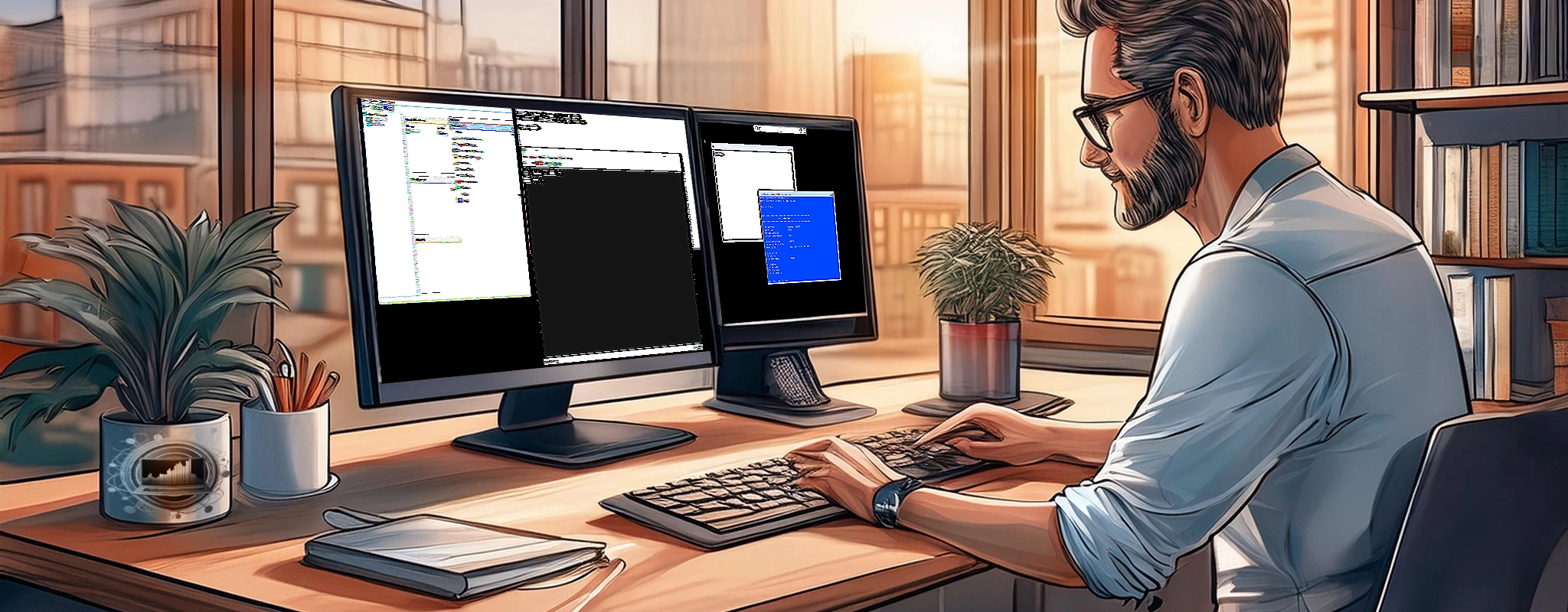
Setting Up a WordPress Web Server

When I decided to repurpose an older AMD FX-8000 series computer into a WordPress web server, I knew it wouldn’t be a straightforward task. This machine had once been a reliable VMware ESXi host, but a security patch corrupted the installation and left me searching for an alternative. Despite having backups, the incident revealed the limitations of using VMware ESXi—particularly its licensing model and the challenges of recovering from corruption. This project became a journey of learning, problem-solving, and ultimately, creating a cost-effective, high-performance WordPress web server.
Why I Chose Hyper-V 2019 for Setting Up a WordPress Web Server
VMware’s shift toward subscription-based licensing made it an unappealing option for my needs. For a personal project, I wanted a hypervisor that provided bare-metal performance without ongoing costs. While I briefly considered VirtualBox, it relies on a host operating system, consuming more resources. Hyper-V 2019 stood out as the ideal choice—a free, bare-metal hypervisor supported by Microsoft and capable of running efficiently on older hardware like my AMD FX-8000 series processor.
Hyper-V 2019 has several advantages over other options. It bypasses the overhead of a host operating system, directly leveraging the hardware for virtualization. For my aging machine, this efficiency was crucial. The AMD FX-8000 series processor had been powerful in its time but wasn’t designed for today’s resource-heavy applications. Hyper-V’s streamlined operation allowed me to get the most out of the hardware.
Another key reason for choosing Hyper-V was its stability and support. Unlike subscription-based VMware products, Hyper-V 2019 remains free and is backed by Microsoft. The combination of cost savings, compatibility with older systems, and bare-metal performance made it the clear winner for this project.
For more information about Hyper-V, check out Microsoft’s official Hyper-V page.
The Setup Process for a WordPress Web Server
Setting Up Domain Hosting, DNS, and Networking Configurations for Hyper-V
Since I was hosting the WordPress server on my own Hyper-V environment, setting up domain hosting, DNS, and networking required careful planning. The goal was to make the website accessible externally while ensuring stability and security for internal management.
Domain Hosting and DNS Configuration
To associate a domain name with my self-hosted WordPress server, I registered a domain with a reliable domain registrar that supports custom DNS configurations. The next steps involved pointing this domain to my home server’s public IP address.
- Configuring Public DNS Records:
- I updated the A Record at my domain registrar to point the domain to my public IP address.
- I set up a CNAME Record for
www.example.comto redirect traffic toexample.com. - I configured MX Records for email services.
- Since my ISP assigns dynamic IPs, I implemented Dynamic DNS (DDNS) with a service like No-IP to keep the domain updated with my changing IP.
- Setting Up an Internal DNS Server:
- To avoid unnecessary external lookups while accessing the site from within my network, I configured an Unbound DNS server locally.
- This DNS server allowed me to resolve
example.cominternally, reducing latency. - I added internal DNS entries for local services to improve resolution speeds.
Networking Configuration in Hyper-V
Networking inside Hyper-V was a critical step to ensure the virtual machine running WordPress had proper internet access while remaining secure from potential threats.
- Creating a Virtual Switch:
- I set up an External Virtual Switch to bridge the virtual machine to the physical network, allowing it to communicate externally.
- The virtual switch was assigned to the correct network adapter to prevent conflicts.
- Assigning a Static IP to the Virtual Machine:
- Inside Ubuntu Server, I assigned a static IP address via
/etc/netplan/. - This prevented DHCP from changing the IP, ensuring stable access to the WordPress server.
- Inside Ubuntu Server, I assigned a static IP address via
- Router and Firewall Configuration:
- I configured port forwarding on my router to allow external access:
- 80 (HTTP) for web traffic.
- 443 (HTTPS) for secure connections.
- 22 (SSH) for remote management (restricted to specific IPs).
- I implemented strict firewall rules on both my router and Ubuntu’s
ufwfirewall. - Geo-blocking was enabled to restrict access from unwanted locations.
- I configured port forwarding on my router to allow external access:
- Securing the Server:
- I installed Fail2Ban to block repeated unauthorized access attempts.
- Let’s Encrypt SSL was used to encrypt traffic, enhancing security.
- I disabled root login over SSH and used key-based authentication for remote access.
With these configurations in place, my self-hosted WordPress server was accessible via its custom domain name, secured with proper firewall rules, and optimized for stability within the Hyper-V environment.
Repurposing the Hardware for WordPress Hosting
Transforming the AMD FX-8000 series desktop into a server was the first step. Although the hardware was no longer cutting-edge, it was more than sufficient for hosting a WordPress site. The process began with enabling AMD-V virtualization in the BIOS. This step ensured Hyper-V could fully utilize the processor’s capabilities. I also took the opportunity to clean and optimize the machine, replacing thermal paste and ensuring adequate cooling for extended operation.
Installing Hyper-V 2019 went smoothly, but configuring it for headless operation presented challenges. Hyper-V is designed for remote management, requiring PowerShell remoting and specific firewall configurations. I spent hours troubleshooting connectivity issues before finally establishing a stable remote connection. Each small win—like successfully creating a remote session—motivated me to keep going.
Networking was another hurdle. Creating an external virtual switch to connect the virtual machines to the broader network required trial and error. Misconfigurations led to frustrating moments when the VMs couldn’t access the internet or communicate with the host. Eventually, I identified the correct settings and saw the network come to life. That moment, when everything clicked, felt incredibly rewarding.
If you’re interested in more details on setting up Hyper-V networking, I recommend this updated guide from TechDirectArchive.
Choosing Ubuntu Server for the WordPress Web Server
With Hyper-V operational, I needed an operating system for the virtual machine. I chose Ubuntu Server for its lightweight design, stability, and compatibility with the LAMP stack. Having used Ubuntu for previous projects, I was familiar with its strengths, but this was my first time working exclusively with the headless version. The lack of a graphical interface added complexity but also taught me valuable skills in managing servers via the command line.
The Ubuntu Server installation was straightforward, but configuring the network required precision. Assigning a static IP was essential for consistent remote access, and this involved editing YAML configuration files in /etc/netplan. Even minor errors in these files could disrupt connectivity, leading to a cycle of edits, tests, and corrections. Despite the frustration, each correction brought me closer to a functioning network setup.
SSH was another critical component. It allowed me to manage the server remotely, but securing it was equally important. I implemented key-based authentication, disabled password logins, and restricted root access. These steps ensured that the server would be secure while remaining accessible for management tasks.
To learn more about securing SSH, refer to this guide from DigitalOcean.
Building the LAMP Stack for the WordPress Web Server
The LAMP stack—Linux, Apache, MySQL, and PHP—is the backbone of many web servers, including those running WordPress. Installing and configuring each component on Ubuntu Server was a step-by-step process that required attention to detail to ensure compatibility and security.
To streamline parts of this process, I utilized ChatGPT to help craft bash scripts. These scripts automated repetitive tasks like installing and configuring Apache, MySQL, and PHP, saving me significant time. For instance, one script set up virtual hosts in Apache, while another initialized MySQL with a secure configuration and created the database for WordPress. These tools not only sped up the process but also ensured consistency across configurations.
Apache, the web server, was the first piece of the stack. While installing Apache was simple, configuring it for WordPress took extra effort. I created a virtual host configuration to handle requests for the WordPress site and enabled necessary modules like mod_rewrite for SEO-friendly URLs. Testing the setup by loading Apache’s default page in a browser confirmed that the web server was working as expected.
Next came MySQL, the database management system. I created a dedicated database and user for WordPress, ensuring secure access with a strong password. Configuring MySQL user permissions required careful planning to prevent unauthorized access while allowing WordPress the functionality it needed.
PHP was the final component of the LAMP stack. Installing PHP and its necessary modules, like php-mysql, was straightforward. However, testing the setup to ensure WordPress compatibility required creating a PHP info page and resolving any missing dependencies. Completing the LAMP stack was a significant milestone that brought the project closer to its goal.
For detailed steps on setting up a LAMP stack, check out this tutorial from Ubuntu.
Installing WordPress on the Web Server
Installing WordPress was the culmination of the setup process, but it wasn’t without challenges. After downloading and extracting the WordPress files into the web server’s root directory, I needed to configure the wp-config.php file with database credentials and other essential settings. Ensuring these details were correct was crucial for the site to function properly.
Permissions were another key consideration. WordPress requires access to certain files and directories, but overly permissive settings can create security vulnerabilities. Striking the right balance between functionality and security took careful planning and testing. I adjusted ownership and permissions on the necessary directories to ensure WordPress could operate without compromising the server’s integrity.
Accessing the WordPress setup wizard in my browser was a rewarding moment. The wizard guided me through configuring the site title, admin account, and initial settings. Seeing the WordPress dashboard for the first time on a server I built from scratch felt like a significant accomplishment.
For WordPress optimization tips, visit WordPress.org’s official guide.
Challenges Along the Way
This project was not without its share of frustrations. Networking issues were among the most persistent challenges. Configuring static IPs and ensuring proper communication between the host and VMs often felt like a game of trial and error. Each failed attempt was an opportunity to learn, but the process tested my patience.
Another challenge was balancing automation with manual configuration. While ChatGPT-generated scripts saved time, they occasionally needed adjustments to fit the specific nuances of my setup. Debugging these scripts taught me a lot about the intricacies of the LAMP stack but also added complexity to the project.
Security was a major concern. Exposing a server to the internet comes with inherent risks, and securing it required diligence. I spent considerable time configuring firewalls, hardening SSH access, and implementing SSL/TLS for encrypted communications. While these steps were time-consuming, they were essential for protecting the server and its data.
Despite these challenges, each problem I solved brought a sense of accomplishment. The project reinforced the importance of persistence and problem-solving in technical work. Every setback became a chance to deepen my understanding of the systems I was working with.
Wins and Key Takeaways
Repurposing an old desktop into a functional WordPress web server was a rewarding experience. It demonstrated the value of leveraging free tools like Hyper-V and Ubuntu Server to achieve professional results without incurring significant costs. The addition of ChatGPT-generated scripts highlighted how AI can simplify complex setups and ensure consistent configurations. (scripts used will be added to IT Resources when page complete or on github).
One of the biggest wins was the deeper understanding I gained of how these systems work together. From the hypervisor to the operating system to the application layer, each component played a critical role. Successfully integrating them into a cohesive whole was a testament to the power of free software and the potential of repurposed hardware.
The use of automation in this project was another key takeaway. Writing and debugging scripts taught me the value of repeatable processes, especially for tasks that would otherwise consume hours of manual effort. These scripts now serve as a template for future projects.
The Outcome
The finished product is a secure, scalable, and efficient WordPress web server. It’s optimized for the hardware it’s running on and meets all my needs for personal web hosting. Knowing that I built this system from the ground up makes it even more satisfying to use. Beyond that, it serves as a testament to the value of repurposing technology and the potential of free software to achieve professional results.
By leveraging automation and learning through challenges, I now have a deeper understanding of server infrastructure and a reusable set of scripts for future projects. This outcome far exceeded my initial expectations.
Reflecting on the Experience
This project wasn’t just about setting up a WordPress web server; it was a journey of growth and learning. It reminded me why I love working with technology—the challenges, the problem-solving, and the satisfaction of creating something meaningful. While there were moments of frustration, they were far outweighed by the sense of accomplishment that came with seeing the project through to completion.
Utilizing ChatGPT for script creation was a game-changer. It not only saved time but also provided an opportunity to learn more about scripting and automation. This experience demonstrated how AI tools can complement technical expertise, streamlining processes while maintaining flexibility.
For anyone considering a similar project, my advice is to embrace the process. It won’t always be easy, but the rewards are worth it. Whether you’re repurposing old hardware or exploring new software, there’s something deeply satisfying about creating something from scratch and making it your own.
